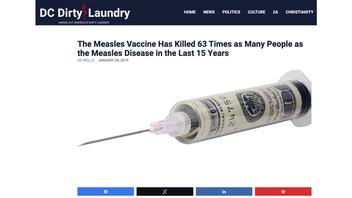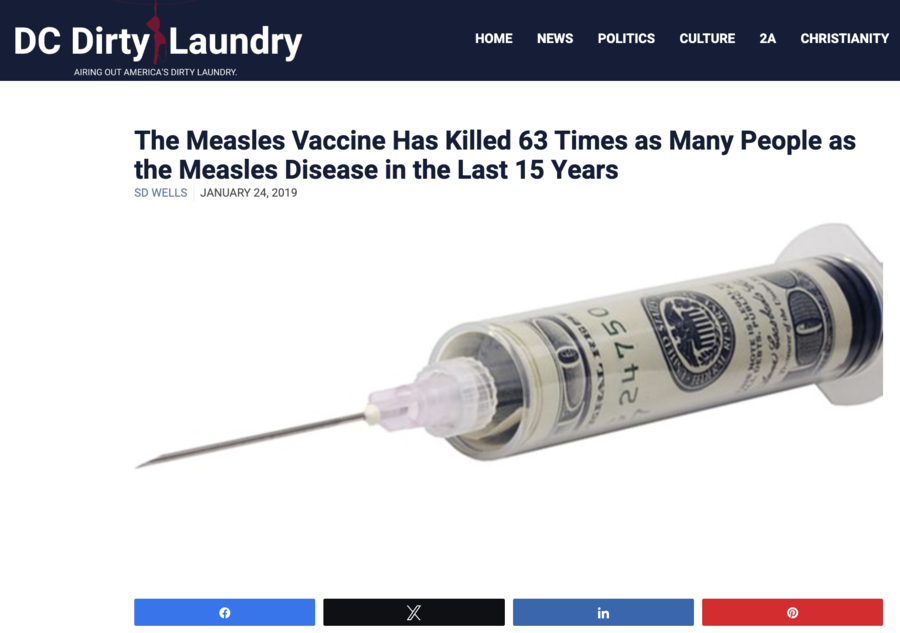STORY UPDATED: check for updates below.

Is measles vaccination proven to have caused "63 times more" deaths than measles in the United States between 2003 and 2018? No, that's not true: Lead Stories found zero credible sources confirming that. The claim that has been circulating on social media and beyond since at least 2015 manipulates the vaccine adverse effect reports, conflating coinciding events with causation that has never been proven.
A variation of the claim reappeared in an article (archived here) on the website named "DC Dirty Laundry" on January 24, 2019, under the title:
The Measles Vaccine Has Killed 63 Times as Many People as the Measles Disease in the Last 15 Years
This is what it looked like at the time of writing:
(Source: DC Dirty Laundry screenshot taken on Tue May 21 14:26:45 2024 UTC)
In 2024, it continued to circulate on social media as a screenshot reappearing from older posts (archived here).
The article failed to explain how its author arrived at the figures cited in the headline. A Google search utilizing the cited number among the keywords seen here (archived here) showed no credible sources corroborating the claim.
A deeper dive into the references from the piece reveals that the factually incorrect conclusion was based on a flawed assumption that ignored a difference between unproven correlation and causation. And even that did not explain the origins of the idea of "63 times more people" that appears to have entered the article without any supporting evidence at all.
Sources
The first paragraph of the DC Dirty Laundry article opened with a link to Natural News. In 2019, the Atlantic (archived here) described it as one of the most prolific spreaders of anti-vaccine misinformation and conspiracies. The website used such aggressive practices to amplify its content that by 2020, Facebook had banned it twice, as reported by Vox (archived here).
In the second paragraph, the DC Dirty Laundry piece cited a Natural News article (archived here) published four years prior, in 2015, as a source claiming that more people die from the measles vaccine "than would ever pass from contracting the disease naturally." That piece stated that between 2005 and 2015, measles vaccines resulted in "108 deaths" in the U.S. while measles caused none.
But that was not the number of the cases with confirmed, scientifically proven links between vaccination and fatal events -- that was the supposed number of VAERS entries mentioning deaths and vaccinations. VAERS is an informal and un-tested collection of notes that can be posted by anyone with an internet connection, about vaccines. The full name is the Vaccine Adverse Effect Reporting System (archived here). If patterns emerge from the mass of raw data, scientists can painstakingly study reports case-by-case to see if the pattern means anything.
A CDC spokesperson told Lead Stories via email on May 24, 2024:
The system is not designed to determine whether a reported adverse event was caused by vaccination... Since VAERS data cannot determine causality, we cannot use it to provide numbers of deaths caused by vaccination.
Before anyone can search the VAERS database, they are required to acknowledge that they read a disclaimer (archived here) explaining its limitations and what VAERS reports do and do not mean:
Anyone, including healthcare providers, vaccine manufacturers, and the public, can submit reports to the system. While very important in monitoring vaccine safety, VAERS reports alone cannot be used to determine if a vaccine caused or contributed to an adverse event or illness. ...
VAERS reports may contain information that is incomplete, inaccurate, coincidental, or unverifiable. Reports to VAERS can also be biased. As a result, there are limitations on how the data can be used scientifically. Data from VAERS reports should always be interpreted with these limitations in mind.
Yet, the second "piece of evidence" used in the article that is the focus of this fact check --- a 2018, now deleted YouTube video only available in the archived version -- also brought up uncritically cited VAERS reports. In it, a person named Alvin Moss argued in support of loosening vaccination requirements in West Virginia. He was seen claiming that while there were two deaths in the U.S. from measles between 2003 and 2018, there were 127 deaths purportedly related to measles vaccines. Moss is not a virologist -- his medical area of expertise is kidney diseases (archived here). In March 2024, the state's governor vetoed such a bill (archived here).
The YouTube video featuring Moss was not a news report and did not include the opponents of the measure -- it was spread by an anti-vaccination nonprofit named Learn the Risk previously known as the Council for Vaccine Safety (archived here), though it was unrelated to any bodies governing federal health agencies. In 2019, the Council for Vaccine Safety was banned from crowdfunding on Facebook aimed at funding their anti-vaccination campaigns (archived here).
The Google fact check database contains numerous examples of false claims incorrectly citing VAERS data. Lead Stories debunked those claims on multiple occasions too.
What is proven
The article on DC Dirty Laundry opens with an acknowledgment that in the 1960s the number of global deaths from measles dropped, but it omits the reason: the invention of the measles vaccine.
The Centers for Disease Control and Prevention website (archived here) says:
Before the measles vaccination program started in 1963, an estimated 3 to 4 million people got measles each year in the United States. Of these, approximately 500,000 cases were reported each year to CDC; of these, 400 to 500 died, 48,000 were hospitalized, and 1,000 developed encephalitis (brain swelling) from measles. Since then, widespread use of measles virus-containing vaccine has led to a greater than 99% reduction in measles cases compared with the pre-vaccine era.
Between 2000 and 2022, the estimated number of annual measles-related deaths decreased from over 770,000 to 136,000 worldwide.
In 2019, when the article that is the focus of this fact check went online, measle cases spiked globally, reaching the highest level in 23 years. According to the World Health Organization (archived here), it caused 207,500 deaths that year, climbed nearly 50 percent from the 2016 figure.
Though the U.S. announced that measles was eliminated in the country in 2000, since then many outbreaks have occurred. As of May 2024, there were 139 cases nationwide (archived here), and more than half the infected needed hospitalization.
T
It continues:
The World Health Organization (archived here) emphasizes that any population in the world has a certain mortality rate and some of it will eventually coincide with vaccination, though that alone does not establish any connection:
Knowledge of these background rates of disease and deaths, particularly age specific disease incidence rates, allows estimation of the expected numbers of coincidental events. For example, let us assume that one million children aged 1-15 years are immunized in a mass campaign and the background age specific mortality rate for this population is 3 per 1000 per year. Then, 250 deaths can be expected in the month after immunization and eight deaths on the day of the immunization, simply by coincidence. These deaths will be temporally associated with, even though entirely unrelated to, immunization.
Other Lead Stories fact checks about health-related topics can be found here.
Updates:
-
2024-05-24T22:43:02Z 2024-05-24T22:43:02Z Update to add response from the CDC: That VAERS reports cannot be used to establish causality.

















